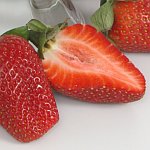|
|
|
Strawberry Fruit Facts Page Information
|
Availability by variety
|
 The strawberry you eat is not really a fruit or a berry but
is the enlarged receptacle of the flower.
The strawberry you eat is not really a fruit or a berry but
is the enlarged receptacle of the flower.
Strawberries are grown in every state in the U.S. and every
province in Canada. California produces 80% of the nation's
strawberries, providing almost a year-round supply. California
strawberry growers and researchers, along with help from the most ideal
growing conditions, work together to produce the highest quality
strawberries you can buy.
There are approximately 700 strawberry growers in California producing
fruit on over 20,000 acres annually. The strawberry shipping season
begins in January in the southern part of the state and moves north with the
warming springtime temperatures. Volume peaks in April and May when all
production areas overlap. During this time, weekly volume can approach 5
million trays or just over 9 million pounds a day.
Strawberries were cultivated in ancient Rome and were used as a medicinal
herb in the 13th Century. They are a member of the Rose family. A museum dedicated
to them in Belgium. During the 1700's, a hybrid variety was developed in
France by breeding wild strawberries brought from North America with others
from Chile. The first important American variety, the Hovey,
was grown in 1834 in Massachusetts.
Nutrition and Consumption:
One serving of strawberries contains 20% RDA of folic acid.
That's more per comparable serving than any other fruit. Folic acid is a
water-soluble B vitamin which has been proven to reduce birth defects
involving brain and nerve disorders. Strawberries are one of the most
delicious and nutritious fruits. According to FDA regulations,
strawberries are a sodium-free, fat-free food. They are not only cholesterol
free but low in calories as well.
One serving of eight medium sized strawberries contains:
· 140% of the U.S. Recommended Daily Allowance of Vitamin C, which is more than one orange.
· 20% of the daily value for folic acid.
· Only 50 calories.
· No fat grams.
· Recognized source of potassium, folacin and dietary fiber.
· Approximately 50% of this total dietary fiber is a water soluble pectin.
· Clinical studies that soluble fibers help reduce serum cholesterol levels.*
Detailed nutritional informatin can be found by searching the
USDA Nutritional Database
. Enter "Strawberry" (no quotes) as the keyword and select the link and report of interest.
Scientific classification:
The strawberry belongs to the genus Fragaria in the rose family,
Rosaceae. The scientific names for some common American species are F.
chiloensis, F. vesca, and F. virginiana.
|
|